News | What’s Cool in Transportation – Electric Vehicles (part 3)
Stop the VideoNews

Shichun Hu, MSISE 2017
Welcome back to What’s Cool in Transportation! Previously, we discussed the history, the status, and the core battery techniques of electric vehicles (EVs). And today we will finish this series about EVs.
What will this piece be about? You may reasonably guess it will be on the future of EV, or perhaps the differences between different EVs (hybrid, plug-in charge, etc.). But our last column won’t be on any of these topics. I don’t know for the majority out there, but for myself, the single most intriguing question about an EV is whether it could actually reduce carbon emission.
The main advantage of promoting electric vehicles over traditional gasoline cars is that EVs emit less CO2 and can help prevent global warming. Undoubtedly, this statement is true while the comparison is limited to the in-service stage. However, there is more to the impact of a product than just what happens while it is in use by the consumer. Let us investigate if this statement still holds throughout the lifecycle of EVs.
There are three main stages for a vehicle - and in each, it could potentially generate CO2. These are: 1) Manufacturing (including all resources such as materials and energy used to manufacture the vehicle); 2) Operation (driving) and Powering (the power source origin); 3) The recycling and disposal stage.
The most significant differences between an electric vehicle and a gasoline vehicle that determine the majority of global warming emissions are:
- Different powering system: large battery pack versus internal combustion engine
- Weight and material differences
In a rigorous research conducted by The Union of Concerned Scientists [1], they selected Nissan LEAF as their midsize battery electric vehicle (BEV) and Tesla Model S as their full-size BEV to represent the short range and long range EVs and then compared them with equivalent (in size) gasoline vehicles. The specifications are shown in the tables below. We can see that BEVs are generally 10% heavier than gasoline vehicles.
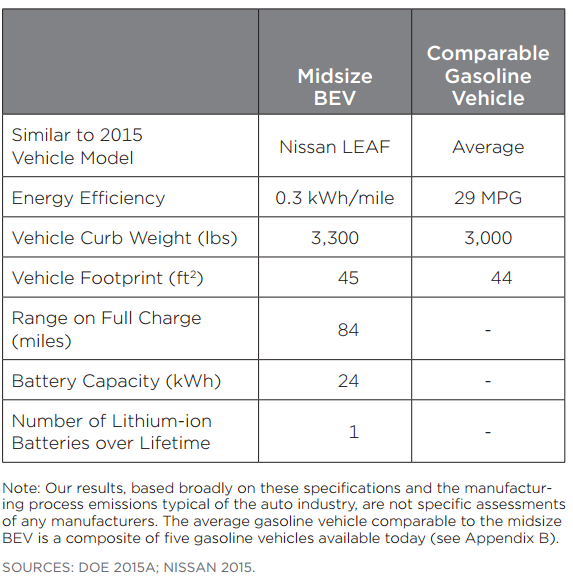
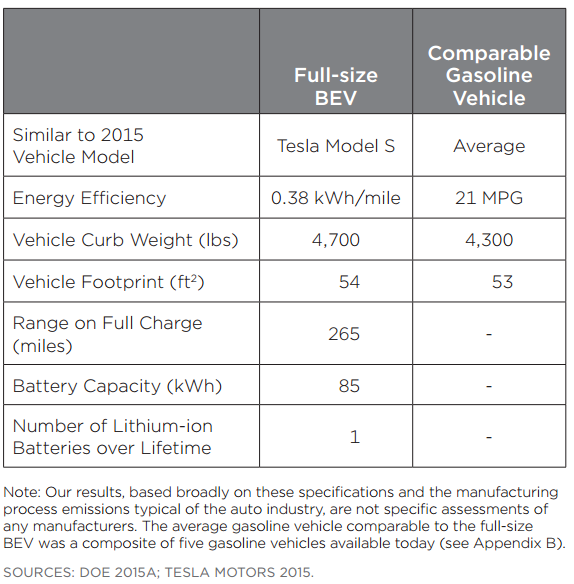
Based on the specifications above, the Union of Concerned Scientists found out that for a midsize 84-mile-range BEV, manufacturing emissions are approximately 15 percent, or 1 ton of CO2 higher than those of a comparable conventional gasoline vehicle while for a full-size 265-mile-range BEV, manufacturing emissions are approximately 68 percent, or 6 tons of CO2e higher than a comparable conventional gasoline vehicle. Extra assumptions like battery life (assume one battery pack over BEV’s lifetime), vehicle recycling (assume only typical recycling level and exclude the recycle of battery), and vehicle disposal (assume both BEV and gasoline vehicles emit similar global warming gas) are made during the research.
Although the two EV types this research chose may not fully represent the current EV market, this still provides us with a clearer picture of the carbon footprint of battery electric vehicles. The higher emissions during manufacturing can be attributed to larger batteries used in EV that emit extra global warming gas compared with the gasoline vehicle production line. And remember, the finding only assumed one battery pack over the lifetime. The emission would certainly be higher if a second or a third battery pack came into use.
The finding above may surprise you in that now we know that EVs are not as “green” as we thought. But don’t feel upset yet, we still have the operation and power stage unexamined and this is the stage that contributes a larger part of the emission in the long run.
For this stage, it’s obvious that a battery electric vehicle carbon emission can be omitted; by comparison, a gasoline vehicle emits 8,887 grams of CO2 per gallon of gasoline consumed[2]. Putting it in the same situation as above, this is equivalent to 306.4 grams of CO2 per mile for midsize gasoline vehicles and 423.2 grams for full-size gasoline vehicles. What does this mean? Well, intuitively, it means that the extra CO2 generated during the manufacturing stage can be offset by driving more than 3,264 miles or 14,177 miles in midsize BEVs and full-size BEVs under the circumstances where BEVs are charged through an ideal grid with no CO2 generated. This can be easily achieved in a car-oriented country like the United States. According to data published on Department of Transportation [3], the average annual miles traveled across the country annually per vehicle is 13,476 miles. Therefore, ideally, the battery manufacturing GHG emissions will be offset within 1.5 years! Isn’t that nice?
However, no country in the world now can confidently claim that their electricity grid is 100% green. As a result, our positive estimate of 1.5 years as a break-even point is currently unachievable. Most countries are still using fossil fuels (natural gas, coal and petroleum) as their major electricity source. The pie charts [4] below give you an idea of how electricity is generated throughout the world and in some major countries and zones.
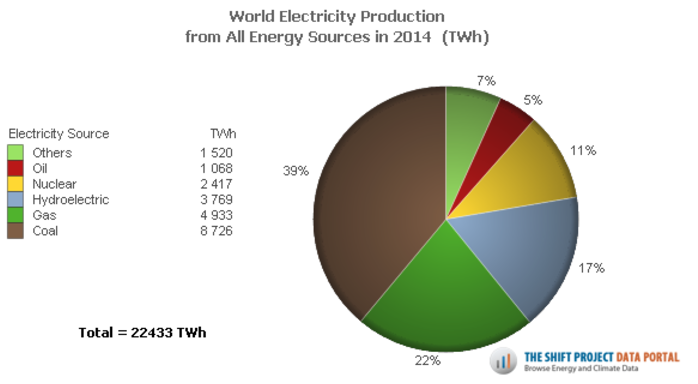
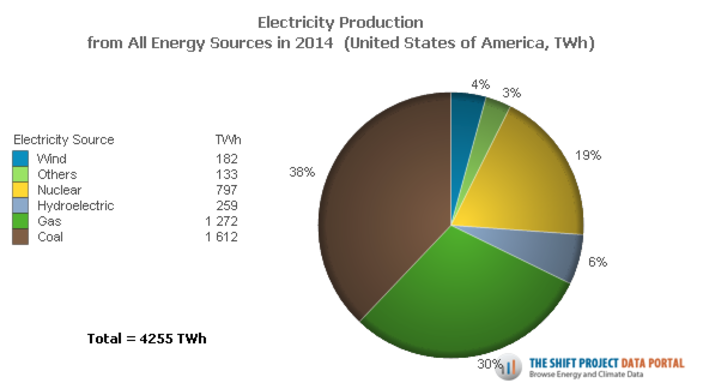
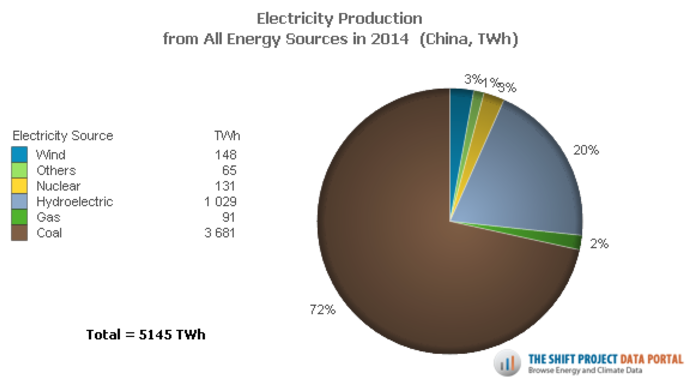

As we can see, European countries are leading the way to green electricity; around 41% electricity comes from fossil fuels in 2014 in those countries while large countries like U.S. and China are a bit far behind with the numbers being 68% and 74% respectively. To better understand how different sources of electricity contribute to GHG, here is a way of comparing them: The Union of Concerned Scientists created an index called the MPGghg, which can be understood in the given manner: “If an electric vehicle has an MPGghg value equal to the MPG of a gasoline powered vehicle, both vehicles will produce the same amount of global warming emissions for each mile traveled.” Using this index, they evaluated and created a table below to show how different electricity source affect the GHG efficiency of an electric vehicle.
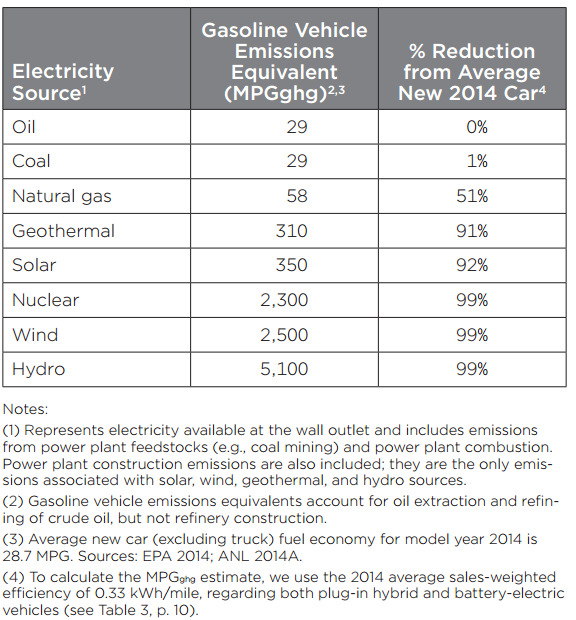
Combining the data above, let’s go back to the content where we used midsize and full-size BEV as examples. We could work out that when powered by the electricity grid mix in the U.S. today, those extra manufacturing emissions of midsize BEVs are o?set within the first 3,700 miles (cleanest grid region) to 13,000 miles (dirtiest grid region) of driving. The number range is 15,000 miles to 39,000 miles for the full-size BEVs. In consequence, we could comfortably say that even in the worst case, 3 years of drive would be enough to have electric vehicles work its “making the world greener” charm. Still pretty good!
To sum up, here is a comprehensive comparison chart created by The Union of Concerned Scientists that can best represent the GHG emission efficiency electric vehicles have throughout their lifetime:

In total, a midsize BEV can save 29 tons of CO2 emission. And a full-size BEV can save 54 tons of CO2. These numbers will be larger if more renewable energy sources are deployed.
So, suffice it to say, one can definitely say that electric vehicles do help reduce CO2 emission and are arguably worth buying after all!
References
[1] R. Nealer, D. Reichmuth, D. Anair. Cleaner Cars from Cradle to Grave. http://www.ucsusa.org/assets/upload/news/attach/2015/11/Cleaner-Cars-fr...
[2] EPA. Greenhouse Gas Emissions from a Typical Passenger Vehicle. https://www.epa.gov/sites/production/files/2016-02/documents/420f14040a.pdf
[3] USDOT FHWA. Average Annual Miles per Driver by Age Group. https://www.fhwa.dot.gov/ohim/onh00/bar8.htm
[4] Breakdown of Electricity Generation by Energy Source. http://www.tsp-data-portal.org/Breakdown-of-Electricity-Generation-by-En...
Shichun Hu
Author Shichun Hu is a student assistant at METRANS Transportation Center specializing in research project administration and coordination of the METRANS Mentor Program. She is a 2nd-year graduate student majoring in Industrial and System Engineering in the Viterbi School of Engineering, USC. Her interests are using data and operation research methods to interpret and reason certain phenomena and she is especially interested in improving urban logistics and the supply chain. Shichun can be reached at [email protected].
News Archive
- December (1)
- November (6)
- October (4)
- September (2)
- August (3)
- July (4)
- June (3)
- May (7)
- April (8)
- March (11)
- February (8)
- January (7)
- December (7)
- November (8)
- October (11)
- September (11)
- August (4)
- July (10)
- June (9)
- May (2)
- April (12)
- March (8)
- February (7)
- January (11)
- December (11)
- November (5)
- October (16)
- September (7)
- August (5)
- July (13)
- June (5)
- May (5)
- April (7)
- March (5)
- February (3)
- January (4)
- December (4)
- November (5)
- October (5)
- September (4)
- August (4)
- July (6)
- June (8)
- May (4)
- April (6)
- March (6)
- February (7)
- January (7)
- December (8)
- November (8)
- October (8)
- September (15)
- August (5)
- July (6)
- June (7)
- May (5)
- April (8)
- March (7)
- February (10)
- January (12)















